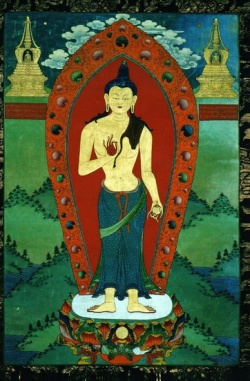Chanshi
Chanshi 禪師
The title chanshi (禪師) appeared in different contexts during the Ming. In one documented case, the Chinese monk Fudeng (or Miaofeng, 1540-1613), a master builder and renowned monk who enjoyed the patronage of Empress Dowager Li for thirty years during the Wanli (萬曆) reign period, was given the title Huguo chanshi (Protection of the Dynasty Chan Master). He received this title, as well as the position of abbot, after completing the rebuilding of Xiantong monastery (now renamed Da huguo shengguang yongming) at Wutaishan.
In the context of the Ming court’s relations with Tibetans, however, the title chanshi was imbued with additional meaning and significance. Lamas from Honghua temple (弘化寺) in Qinghai were granted the title Puying chanshi (普應禪師) and played a significant role in the military defense of the Ming border with Mongolia. Located on the very fringes of the Ming borderlands, Honghua si played a dual role as a temple and also a fortress with a military garrison and beacon tower serving the Ming empire. The Puying chanshi sent tribute to the Ming court and maintained frequent relations between his Dge lugs pa temple, where Shakya Yeshe’s reliquary stupa resided, and the imperial center.
The founder of Honghua si, Zhang Xingjizangbu (張星吉藏卜, Tib. Seng ge bzang po), was granted the titles of guoshi (國師) and chanshi and the right to pass them down to his successive tuyi (徒裔). The exact meaning of “tuyi” remains unclear. However, another source indicates that at Maying si (馬營寺), a branch monastery near to Honghua si whose name is often confused with the latter, the title chanshi was passed down to the son of a brother. Maying si was associated with the Lingzang (靈藏) tribe, and a Lingzhan jiemu (領占節木, Tib. Rin chen rtse mo) was one of the first recipients of the Puying chanshi title. This type of kinship succession system was unusual for the Dge lugs pa, who are most often linked with succession from master to disciple or by transmigration. In the case of Honghua si, this kinship succession system gave the Buddhist temple an extended role as a politically powerful organization run by a local hereditary tribal leader. Indeed, the Xunhuating zhi (循化廳志) explicitly states that the Tibetan officials at Maying si, granted hereditary chanshi titles by letter of imperial authorization, held authority over local tribal people in addition to the monks in their monasteries. When imperial authorization was revoked in 1727, however, the heads of these temples were demoted to the title Dougang (都綱) and afterwards are said to have controlled only their monasteries, not the local populace.
Sources:
Tomoko Otasaka. 1994. A Study of the Hong-hua-si Temple. Memoirs of the Research Department of the Toyo Bunko. 52: 69-101.
Marsha Weidner. 2001. Imperial engagement with Buddhist art and architecture: Ming variations on an old theme. In Cultural intersections in later Chinese Buddhism. Honolulu: Univesity of Hawai'i. pp. 136-139.
Entry by Stacey Van Vleet
